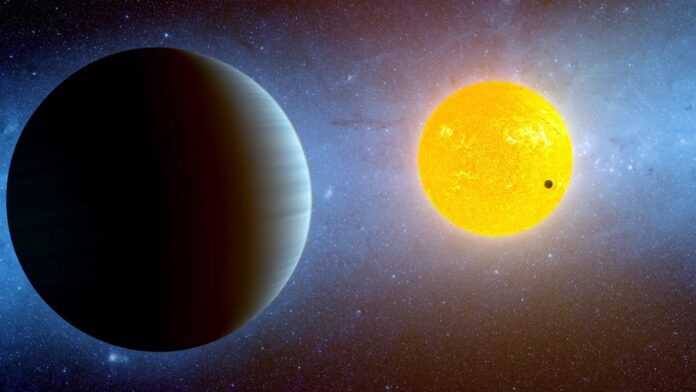Young terrestrial worlds are critical test beds to constrain prevailing planetary formation and evolution theories.
In a star system where two planets were already known, astronomers found something new: a small object passing in front of a star similar in size to the Sun. This object turned out to be an extra-hot and Earth-sized planet.
They named this recently discovered planet HD 63433 d. It’s tidally locked, which means one side faces the star (the dayside), and the other is always in darkness. This exoplanet orbits around the star HD 63433 (also known as TOI 1726) in the planetary system of HD 63433. This planet is extremely hot and is the smallest confirmed exoplanet that’s younger than 500 million years. It’s also the closest Earth-sized planet discovered so far, and it’s about 400 million years old.
A group of astronomers studied this star system using data from NASA‘s TESS (Transiting Exoplanet Survey Satellite). TESS detects “transits,” which happen when planets pass in front of their star, causing a small dip in starlight. In this system, two planets were already known, but the astronomers wanted to find out if there was anything else.
They analyzed the TESS data, removing the signals of the two known planets. Doing this revealed an additional signal: a tiny dip in starlight that occurred every 4.2 days. Investigating further, they confirmed that this was indeed a third, smaller planet.
This newly discovered planet, HD 63433 d, is very close in size to Earth (about 1.1 times the diameter of our planet). It orbits a star similar to our Sun, but it’s much closer to its star. Its “year” is only 4.2 days long, and its dayside experiences extremely high temperatures due to its close proximity to the star. Despite these similarities, it’s a tidally locked planet, meaning one side always faces the star, and the other side is in perpetual darkness. The star in this system is a G-type star, the same type as our Sun.
The newly discovered planet, HD 63433 d, and its star are similar in size to our Earth and Sun, but they’re quite different.
Firstly, this planet is very young, only 400 million years old, while our Earth is 4.5 billion years old. The whole planetary system it belongs to is about 10 times younger than ours.
Moreover, HD 63433 d is much closer to its star than Earth is to the Sun. In fact, it’s 8 times closer than Mercury is to the Sun. This close proximity means the dayside of the planet can get extremely hot, reaching temperatures of about 2,294 Fahrenheit (1,257 Celsius). Because it’s so hot and close to the star, scientists think this small planet might not have a substantial atmosphere.
The extremely high temperatures on HD 63433 d, reaching levels comparable to lava worlds like CoRoT-7 b and Kepler-10 b, have led scientists to believe that the dayside of this planet might be like a “lava hemisphere.”
Due to its small size, young age, and close proximity to its star, this planet is considered an intriguing subject for further investigation. Follow-up studies could verify the findings of this research and potentially provide more details about the planet’s “dark side” (the side that is always in darkness) and the potential presence of an atmosphere. The study emphasizes that studying young terrestrial worlds like this one is crucial for testing and refining current theories about how planets form and evolve.
Journal Reference:
- Benjamin K. Capistrant, Melinda Soares-Furtado et al. TESS Hunt for Young and Maturing Exoplanets (THYME). XI. An Earth-sized Planet Orbiting a Nearby, Solar-like Host in the 400 Myr Ursa Major Moving Group. The Astronomical Journal. DOI: 10.3847/1538-3881/ad1039
